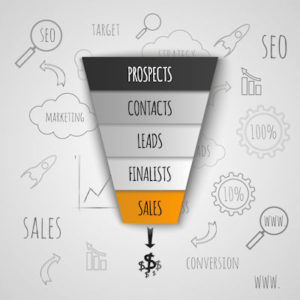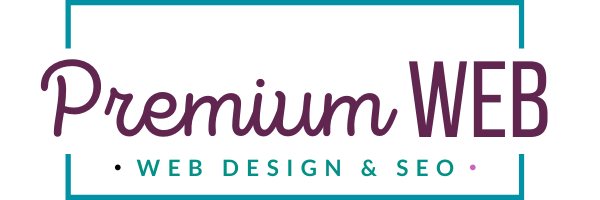What The Heck Is A Sales Funnel, Anyway?

As you can imagine, failing to fully understand this critical part of your business means fewer sales, lower profits, and ultimately, an unstable business.
A Simple Sales Funnel
At its most basic, a sales funnel consists of free content, which typically requires nothing of your readers. Many sales funnels begin with blog posts, YouTube videos, Facebook content, and other information readers can access at no cost. This is the “top” of your funnel.
Next, you’ll have an attractive offer that requires a very small “payment” of sorts – typically an email address. You’ve seen this type of offer on websites all over the internet, and probably even signed up for some. This is the free ebook or guide, video series, checklist, workbook, or other valuable content that is available in exchange for “opting in” to an email list.
Once on your mailing list, you’ll then present your readers with a series of low-cost offers. Perhaps you have a low-priced ebook or a trial membership.
Customers who purchase your low-priced product move further down the funnel, and are presented with more, higher priced products. As they continue to buy, they move closer and closer to your top-end offers, which make up the bottom of your funnel.
How Your Funnel Works
If you imagine your funnel as looking like, well, a funnel, it’s easy to see that your free content—at the top—is consumed by the largest number of readers. Below that, your extreme low-cost item (available only for the cost of an email address) attracts a smaller subset of the true freebie seekers. Next, your low-priced products bring in yet a smaller group.
Finally, as you near the tip of the funnel, only the most loyal of fans and customers will purchase your highest priced offers.
Your job, as the business owner, is to ensure that your funnel leads buyers naturally from the top, free offers all the way to the bottom. The more buyers you can keep in your funnel, the more money you will make.
Most new—and even established—business owners can easily envision the top of the funnel, but if you truly want your business to grow, you must master the entire process, and that starts with understanding what a funnel really is and how it works.
Why Your Funnels Leak – And What To Do About It

If you’ve got a funnel in place, though, and your numbers aren’t looking great, chances are you have a leak somewhere. Your funnel has a hole (or two or three) where subscribers are falling through. There are four common causes for funnel leaks, and once you spot them, they’re pretty easy to fix.
1. Not enough traffic. The very heart of your sales funnel is the traffic you bring in. Without visitors to your blog or opt-in pages, you’ll have no subscribers. Without subscribers, you’ll have no (or very few) sales. Without sales, you’ll have no business. Yet this is where a lot of people struggle. How can you get more eyes on your content and more subscribers into your funnel?
— How to fix it: Traffic generation is an entire industry of its own, but here are some tips: Use good SEO to encourage search engines to rank your content well. Be present and active in the places where your ideal reader hangs out, whether that’s on social media, in niche forums, or at live events. Use paid ads to drive targeted traffic to highly relevant pages. Recruit JV partners and affiliates to promote your offers. Buy solo ads in related email newsletters.
2. No follow-up. This is a leaky funnel mistake that a lot of new entrepreneurs make. They spend a lot of time and energy setting up a great squeeze page and driving traffic to it, then they deliver the goods to their subscribers, and then…nothing. No follow-up emails. No offers to buy more. No related services or products. Nothing.
— How to fix it: Before you spend time building that opt-in page or offer, be sure you have a back-end to promote, or those subscribers you so carefully collected will end up costing you money instead of earning it back.
3. No call-to-action. This happens most typically at the top of the funnel. Your blog posts, social media content, podcasts, YouTube videos—everything you offer for free—must have some kind of call-to-action, or it’s all just wasted energy. Your call-to-action can be as simple as “Subscribe to my YouTube channel” or “Follow me on Facebook for more tips,” but it must be there.
— How to fix it: Every time you write a blog post or an email, as yourself, “What do I want my readers to do when they’re done reading/listening/watching this?” That becomes your call to action so tell them what they need to do. Answer the question “What next?”
4. No product offers. When you’re just starting out, this can be a problem. You know you need to be building a mailing list, but with nothing to offer them, what’s the point? The truth is, there are lots of ways to make money in your funnel even if you don’t have a product to sell.
— How to fix it: Promote affiliate offers. No matter what industry you’re in, there are a variety of tools and products your readers need. Find those tools, sign up for the affiliate programs, and recommend them to your readers. Not only will your readers thank you for pointing them in the right direction, but you’ll earn a little cash, too.
Got a leaky funnel? With a few tweaks and some attention paid to your follow-up sequences, chances are you can fix those holes and increase your profits in no time.
3 Pages Every Funnel Must Have – And What To Include On Them!
Confused about how exactly sales funnels work? You’re not alone. In fact, that’s the number one reason small business owners say they can’t get their funnels set up — they simply don’t know what to include where.
Here’s the easy answer: At the very least, your sales funnel must have three pages.
—> Sales Page
This one obviously comes first. You might call it a landing page, or in the case of a free opt-in, a squeeze page. It serves one purpose — to get the reader to take action. Whether that’s to buy a product or offer up their email address in exchange for a free gift, this is the gateway into your funnel.
Everything that follows depends on this page, so you want to be sure you:
- Include a clear call to action—“Buy Now” or “Click here to download this report for free”
- Eliminate distractions—that means no links to other websites or even a navigation bar
- Address the readers’ pain points and how your offer provides the solution
—> Confirmation Page
Here’s where we ask the reader to confirm their intent. For a sales funnel, this confirmation page might actually be your checkout page. It’s where they enter their payment details. For a free offer, it’s simply the page your email management system directs them to next. It’s a holding page, if you will, while you wait for them to confirm their email address.
If you’re setting up a free funnel, this page has great power—and you don’t want to waste it!
Here is where you can offer an upsell, remind people to follow you on social media, and give them a peak at your other products and services.
Remember, though, that they will only see this page once, so don’t put anything here that they will need to refer back to. That’s what the thank you page is for.
—> Thank You Page
This is where they actually collect their downloadable item, or get information about how your product will be delivered.
Like the confirmation page, this is valuable real estate, so you want to be sure you use it wisely. In addition to the downloadable item your customer just purchased (or opted in for) you also want to showcase your other offers—especially those at a slightly higher price point. Here’s why: the person looking at this page is a hot prospect. He or she is in a buying mood. You want to be sure to take advantage of that by putting your most relevant offers on this page. To encourage buying, consider including:
A limited time offer—scarcity sells, so if you can legitimately limit sales to a few hours/days or number of units, then this is the place to do so.
A “no brainer” coupon offer—an insider’s only deal can be a powerful motivator, especially if it’s a fantastic price.
Extra bonuses—give them access to additional products/services if they buy through your link on that page. These should be bonuses that aren’t advertised on the public sales page for that product. Again—insider’s deals are motivating!
Putting together a sales funnel isn’t complicated—or at least it doesn’t have to be. As your business grows and you have more products to offer, you can expand your funnel to include more upsells and downsells, but for now, this simple setup is really all you need.
Put Your Sales on Autopilot With a Follow-Up Sequence
The web pages that make up your sales or opt-in funnel are only the beginning. To truly encourage sales, you need to stay in touch with your readers to ensure you are top of mind. The easiest way to do that is through an email management system like ConvertKit by sending periodic emails with various related offers.
Let’s take a look at a typical follow-up sequence for a free opt-in series.
In this case, your reader has attended a free webinar that promoted a high-ticket training program. In the days that follow, you’ll want to stay in contact with an autoresponder sequence that automatically sends email at specific intervals.
Email #1: This is going to be the first email that goes out after they confirm. It should give the reader access to your free webinar, so that can be a link to the replay, or that instructions to join you for the live event. You will likely also want to include a couple of reminder emails if they event is live.
Email #2: This is the replay email for a live event, or the first follow-up if the original was a replay. In this email, it’s a good idea to offer few bullet points of what they learned, encouragement to watch the replay (if you can legitimately say it’s only available for the next XX days, even better), plus an offer to purchase the training program.
Email #3: A few days later, you’ll want to follow-up again. This time, consider including a case study of someone who used your training program. When combined with a great offer, reading about the results someone else achieved can be a powerful motivator.
Email #4: Use this follow-up message to remind readers that the replay is going away (if it is), and also to answer any objections. For example, you might list some FAQs or even questions you’ve received about your refund policy, who the program is for, or payment options. Remind them about the offer.
Email #5: This is your final reminder that the offer is going away soon. At this point, you may want to encourage the reader to email you with questions (if you have the systems in place to manage a lot of email, that is).
Email #6 and beyond: If your reader reaches this point without buying, then it may be that your product is just not right for her. From this point forward, you should continue to stay in contact by offering great information, case studies, tips and other interesting content, but also to offer other products that might be of interest.
One important thing to remember about this email sequence: if your reader buys your program at any point, you must remove her from this sequence. It will make no sense for her to get email #5 with that final offer reminder if she purchased your program after email #3. Most autoresponder services, such as ConvertKit, have automation built in that allows you to move subscribers from one list to another based on their actions, so be sure to set that up as you’re building your funnel emails.
This kind of hand’s off approach to email marketing is what will help you build a true passive sales funnel, so look for opportunities to use this system as you build your business.
Top Tool for Building All Your Sales Funnels
Ready to start building out your sales funnels? You’ll need to pick a sales funnel tool.
We recommend a tool called FGFunnels. Let us know if you have any questions.
Sales Funnel Workshop
Subscribe to get the PDF and our latest content by email!


